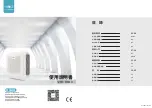
24
LOW AMBIENT CONTROL (FACTORY OPTION)
If the unit comes with Electro-Mechanical (EM) control, then no
adjustment is necessary.
If the unit comes with PremierLink™ or RTU Open control op-
tion, then refer to its installation control manual for details on ad-
justing “Cooling Lock-Out” setting and configure for the specific
job requirements.
INTEGRATED GAS CONTROLLER
This unit contains an Integrated Gas Controller (IGC) board. The
IGC control board uses a flue gas pressure switch that senses pres-
sure drop in the heat exchanger due to the combustion inducer. See
Fig. 41 — Flue Gas Pressure Switch and Pressure Sense
Tube (Typical Location)
When the thermostat calls for heating, power is sent to W on the
Integrated Gas Controller (IGC) board. An LED (light emitting di-
ode) on the IGC board turns on and remains on during normal op-
eration. A check is made to ensure that the rollout switch and limit
switch are closed, and that the pressure switch is open. If the check
was successful, the induced draft motor is energized. When the
pressure in the heat exchanger is low enough to close the pressure
switch, the ignition activation period begins. Once ignition occurs,
the IGC board will continue to monitor the condition of the rollout
switch, the limit switches, the pressure switch, and the flame sen-
sor. Assuming the unit is controlled through a room thermostat set
for “fan auto,” 45 seconds after ignition occurs, the indoor fan mo-
tor will energize, and the outdoor air dampers will open to their
minimum position. If the “over temperature limit” opens prior to
the start of the indoor fan blower, the IGC will shut down the
burners, and the control will shorten the 45 second delay to 5 sec-
onds less than the time to tip the limit. For example, if the limit
trips at 37 seconds, the control will change the “fan on delay”
from 45 seconds to 32 seconds. Once the “fan on delay” has been
modified, it will not change back to 45 seconds unless power is re-
set to the control. On units with 2 stages of heat, W2 closes and
initiates power to the second stage of the main gas valve when ad-
ditional heat is required.
When the thermostat is satisfied, W1 and W2 open and the gas
valve closes, interrupting the flow of gas to the main burners. If
the call for W1 lasted less than 1 minute, the heating cycle will not
terminate until 1 minute after W1 became active. If the unit is con-
trolled through a room thermostat set for fan auto, the indoor fan
motor will continue to operate for an additional 45 seconds, then
stop. An LED indicator is provided on the IGC to monitor opera-
tion.
See Fig. 42 for IGC board component layout. Figure 43 is a typi-
cal IGC control wiring diagram.
Fig. 42 — IGC Board Component Layout
FLUE GA
S
PRE
SS
URE
S
WITCH
FLUE GA
S
PRE
SS
URE
S
EN
S
E TUBE
LOCKING
TAB CONNECTOR
OVERCURRENT FUSE
PROTECTION
REDUNDANT GAS
VALVE RELAY
LOCKING
TAB CONNECTOR
SPADE
CONNECT IGNITOR
Summary of Contents for 582J 04-06
Page 4: ...4 Fig 2 Unit Dimensional Drawing ...
Page 5: ...5 Fig 2 Unit Dimensional Drawing cont ...
Page 21: ...21 Fig 38 Typical Perfect Humidity Adaptive Dehumidification System Humidistat Wiring ...
Page 23: ...23 Fig 40 Typical Control Wiring Diagram Electro Mechanical with W7212 ...
Page 25: ...25 Fig 43 Typical IGC Control Wiring Diagram ...
















































